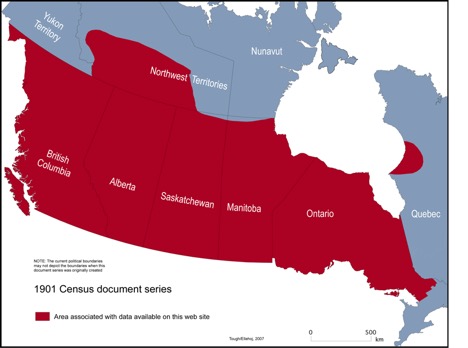1901 Census
Overview
Beginning in 1870, the Dominion of Canada was responsible for enumerating inhabitants of the country through national censuses. These censuses were intended to gather detailed information about individuals and communities. In a new nation undergoing rapid settlement, the early Canadian censuses were a means for the government to keep track of demographic and economic changes occurring in remote parts of the country. The censuses allowed the government to develop policies and plans for settlement, policing, resource use, and other issues.

Historically, large portions of western and northern Canada were referred to, for census purposes, as the “unorganized territory” district. The unorganized district was relatively sparsely populated and geographically remote in comparison to the centres of the political and economic powers (Ottawa and Montréal). Urban and more settled areas of Canada were considered organized districts. In some cases, the types of information collected in the organized districts differs from the unorganized district, and the schedules used for organized districts were more complex and detailed.
The 1901 Census of Canada, in particular, can be very useful for identifying the historical Métis population in both the unorganized and organized territories. In this census, as with earlier censuses, Treaty Indians were enumerated by officials of the Department of Indian Affairs rather than by the regular enumerators. Métis people were enumerated in the regular census but in some districts were clearly identified as “halfbreeds” (the common term used for Métis at the time). Additionally, information on “Colour” attempted to record general racial categories – White (Caucasian), Red (Aboriginal), Black (African) or Yellow (Asian). Métis (and other people with Aboriginal ancestry) in this census were identified consistently as “Red.” Additionally, the category “Racial or Tribal Origin” recorded the “origins,” or cultural backgrounds, of Métis. For example, many Métis were identified as “French Breeds,” “English Breeds,” “Cree French Breeds,” etc. Because of the provision for “Colour” and “Racial or Tribal Origin,” the 1901 census might be described as a racial census by today’s standards; nonetheless, these data categories can be of use in identifying an historical Métis population.
It is important to note that not every individual or family enumerated as “Red” or “Breed” would necessarily have been a member of the historical Métis Nation. The 1901 Census for British Columbia, for example, uses the term “breed” to refer to anyone of mixed ancestry (not specific to Aboriginal/European mixed ancestry). This makes the identification of actual Métis families and individuals in these districts problematic. Furthermore, even when it can be determined that the parentage of an individual was Aboriginal and European, we cannot assume the individual to be Métis, in accordance with the contemporary understanding of Métis cultural/historical identity.
[1] “Métis means a person who self-identifies as Métis, is of historic Métis Nation Ancestry, is distinct from other Aboriginal Peoples and is accepted by the Métis Nation. Furthermore, even when it can be determined that the parentage of an individual was Aboriginal and European, we cannot assume the individual to be Métis, in accordance with the contemporary understanding of Métis cultural/historical identity.”